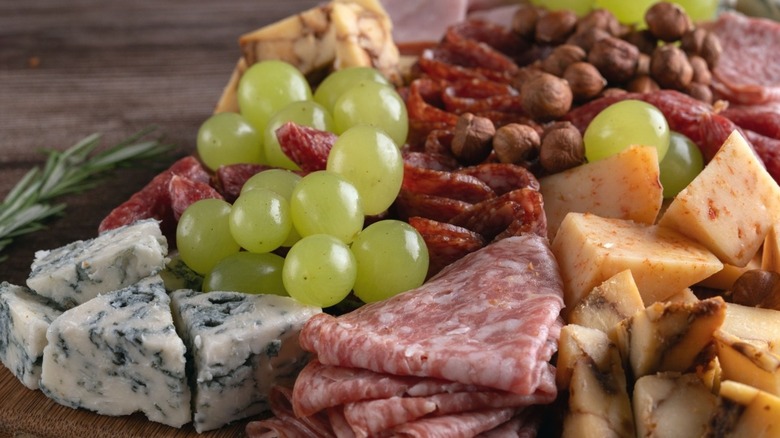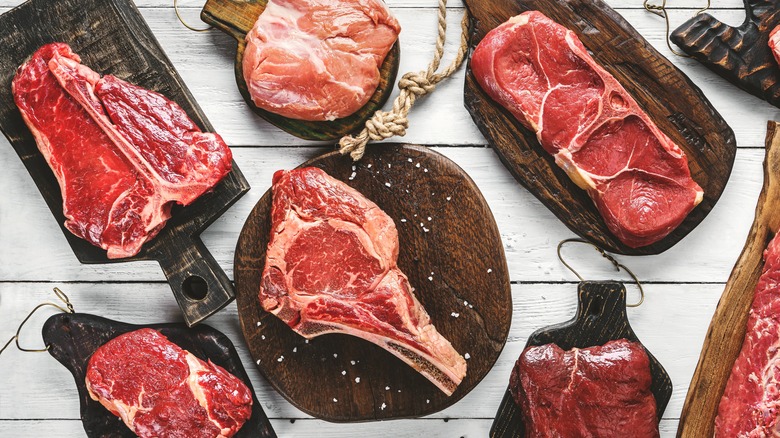Give Your Charcuterie Board A Bougie Twist With An Underrated Addition
Charcuterie boards can be as casual or as fancy as you see fit. If you're just getting together with pals to play a game and have a few beers, a store-bought sampler platter will satiate you. For a cocktail party, you probably want something bespoke, with gourmet cheeses and specialty cured meats. But what if people are likely to be truly, deeply hungry at this shindig? You're going to need something a bit more substantial — and that's where steak comes in. Steak is rich, unctuous, and surprisingly versatile. It's also an easy way to level up your spread without investing in three stinky cheeses you've never heard of, or cured meats from faraway lands with the price tag to prove it.
Adding steak to a well-designed charcuterie board adds delectable textural contrast and enhances the visual appeal of your board. And, if you choose the right cuts prepared the right way, it can be as economical as you need it to be and still seem umlaut-level bougie (that's über-bougie, for the uninitiated).
Choosing the right cuts for your budget
Choosing the best cuts of steak for your charcuterie board requires balancing flavor, presentation, and budget — but mostly budget. Premium cuts are impressive, but budget selections can be just as juicy and flavorful when properly prepared.
Revelers attempting to keep costs low without sacrificing quality can opt for a cut like flank steak or skirt steak. Both are known for robust, beefy flavor. Marinating with a recipe that contains an acid like citrus juice or vinegar (which break down connective tissue) is a must to ensure a tender result, though if you do it right, you can get away with just salt, pepper, and garlic powder on skirt steak. You can grill or pan-sear both, but cook them to medium-rare for best results.
If you've got a higher budget, filet mignon is a classic choice. Best cooked to medium-rare, its tenderness and luxurious, buttery flavor are prized the world over. Or you can opt for a well-marbled and hearty ribeye and showcase its quality by cooking it to medium or medium-rare. Tomahawk is also a flavorful option, but part of its charm (and price tag) is in its dramatic presentation, so save that cut for dinner.
Assembling a steak charcuterie board
Thoughtful assembly starts with choosing the right charcuterie board ingredients to pair with your steak. If you've marinated or seasoned your steak with anything other than a basic marinade or salt, pepper, and garlic, consider the flavor profile. Don't pick anything that would clash with the steak, but do opt for a mix of ingredients that complement and counterbalance it. Sharp cheddar and creamy brie buttress rich, beefy flavors in different ways. Fresh fruits like pulpy, honeyed figs and crisp, tart apple slices add beautiful contrast. Nuts like almonds and pecans add crunch and nuance.
Presentation is also key. This isn't a dinner, so meat slices should be easy to grab with fingers, small tongs, or appetizer forks. Cut the steaks into slices against the grain for maximum tenderness and on the bias for a flawless presentation. Arrange them in an attractive pattern garnished with fresh or charred whole herbs like thyme and rosemary, then surround them with ramekins of dips like grainy mustard or horseradish.
The steak can take its own board, or you can arrange the other ingredients around the star of the show. Either way, deliberate arrangement elevates the charcuterie board to a standout feature at a range of budgets, even if you're just getting together with friends to play a video game.


